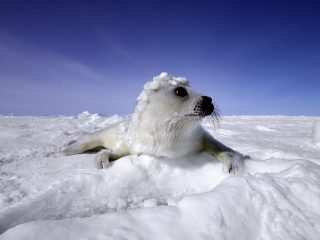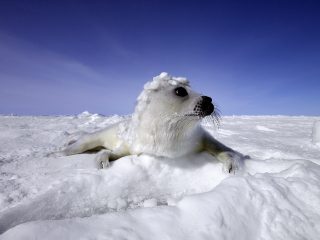

Seal pups slaughtered for sport, not profit
As Canada’s hunting season for baby seals draws to a bloody close, East Coast sealers are trading in their skins for cash. They are finding out their skull-crushing efforts were for naught. Prices were a measly $33 per skin last year, and this season, the bounty plunged further. Pelts fetched from $15 to $17 each, not even enough to cover expenses such as gas money.
The message to hunters is clear.
The world refuses to give its seal of approval to Canada’s barbaric ritual, which has claimed the lives of one million pups in the past four years. The United States has been prohibiting seal products since 1972. And now global markets are shutting down like dominoes: Croatia, Slovenia, Austria, Germany, France, the Netherlands, Belgium, Italy, Panama and Mexico have either banned trade in seal products or announced their intentions to do so. In mid-March, Russian Prime Minister Vladimir Putin banned the hunting of baby harp seals in the White Sea region, labeling the hunt a "bloody business."
"This news regarding the depressed seal pelt prices does offer us a small ray of light in what is otherwise a fairly dark tunnel," said Bruce Foerster, president of the West Coast Anti-Sealing Coalition. "The people we are dealing with here seem more determined than ever to continue this barbaric and senseless slaughter despite there being no market for their bloody harvest."
Supporters of the seal hunt argue that out-of-work fishermen need the money from the skins to supplement their incomes. Seal hunting is an off-season activity conducted by about 5,000 people at the most. Hunters come from Newfoundland fishing villages known for high unemployment rates because of depleted fish stocks.
But the financial data doesn’t support this economic plea. According to Canada’s Department of Fisheries statistics, just 1.3 percent of Newfoundland’s fisheries income came from seals in 2008. Because of depressed pelt prices, that’s expected to dip even lower this year. The rest of the fisheries revenues in the province come from seafood.
After years of pleading their case, animal welfare groups have finally decided to hit the sealers where it hurts most: their wallets. And that meant targeting seafood exports to the United States, a $2.5-billion industry. In 2005, a network of animal welfare groups including Humane Society of United States instigated a Canadian seafood boycott. The ProtectSeals campaign has successfully lobbied 5,000 American restaurants and grocery stores to stop carrying Canadian seafood. Iconic chains such as Whole Foods and Trader Joe’s won’t buy Canadian until the seal hunt ends.
Seafood exports from Newfoundland and Labrador have been halved in recent years. The value of Canadian snow crab exports alone to the U.S. has declined by more than $750 million. The ProtectSeals spokespeople say the boycott is working.
Last year, the seal hunt amounted to just $12 million in gross revenue, and half of that money was eaten up by hunters’ expenses. For a mere $6 million, 300,000 baby seals were cruelly clubbed to death. At least half of them were skinned alive.
This year, sealers won’t break even.
"Why anyone would risk their lives and endure torturous conditions in order to slaughter baby seals for no net return is a mystery to us all, although some sealers have admitted that they do it not for the money but ‘just for the fun of it’," said Foerster.
And revenue figures don’t take into account what the Canadian government pays to keep the business of the hunt supported — probably 10 times that much. So goes the estimate by Toronto lawyer and journalist Murray Teitel.
Traveling to the remote ice floes in the Gulf of St. Lawrence where the baby seals frolic is dangerous, and defies nature. For seven weeks, the Canadian Coast Guard is deployed to help the hunters with a 10-vessel fleet that includes icebreakers, helicopters and patrol planes. Just one of the icebreakers known as The Amundsen costs $50,000 per day to operate in winter.
The fleet helps break up the ice for hunters, and rescues stranded sealers trapped on the ice. Last year, four sealers died. Another two almost lost their lives. Searching for the sealers cost the government many millions of dollars.
And millions more are paid out for boats damaged by ice.
That’s not the only cost.
High-level trade delegations are sent abroad many times a year to argue the merits of importing Canadian seal products. They spend taxpayer money to promote animal cruelty.

Photo courtesy of Nigel Barker.
Carreen Maloney can be reached at carreen@fuzzytown.com
Join the newsletter and never miss out on dog content again!
"*" indicates required fields
By clicking the arrow, you agree to our web Terms of Use and Privacy & Cookie Policy. Easy unsubscribe links are provided in every email.